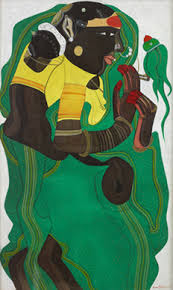Ezhava Sivan
Sree Narayana Guru consecrated several idols, mostly mirrors, which was later developed into big temples. The first of the series was at Aruvippuram in T’puram district. He jumped into the flowing river, raised a stone and installed it nearby. A few Vedic scholars didn’t like the idea. They accosted the Guru and asked to show the relevant portions which gives the authority to an Ezhava to sanctify the stone as Lord Siva.
Narayana guru was cool. He
observed,
“Mine is Ezhava Sivan”.
The hierarchical divisions of
the society had its origins in Kerala by the end of the eighth century. Some
people were made slaves and untouchables. Even a chance sighting of these
unfortunate human beings vitiated the persona of the elite. Temples had a pivotal
role in establishing this social order. The system had a pretty long run 1100
AD to 1950 AD. The temples were fabulously rich on account of enormous land
holdings, inventory of gold and silver, contributions in precious stones, cash
etc. Devaswam and Brahmaswam as they call it. The upper crest who was at the
helm of affairs by virtue of their knowledge about rituals got the reigns of
control and the ownership changed hands. Art and literature which also centered
around temples were not meant for the common folk. The usurpers took it all and kept
it under their strict custody. Freedom
and innovations were unthinkable.
With power on their side, they
dictated terms and the underdogs were banned
from walking through public thoroughfares bordering the temples.
Since temples were used as the
device for wielding power, Guru decided that the same device should be used to seize
power from the elite.
Cleanliness is godliness. Uphold personal hygiene, he stressed. It is the best antidote against untouchability. Who can say ‘No’ to a person, afresh after bath, walking gracefully in clean clothes? Even if someone does, nobody would take it seriously. At the same time make sure that the body should neither be pampered nor tortured. The sensory organs are for optimum usage, i.e., no idle run for them. The person gets additional confidence if his/her words are clean. Qualities like straight-forwardness, compassion, Love, flexibility, courage, shyness, stable temperament etc. clean the mind. Prior to that, the place where he/she resides should also be clean. The house must be energised by direct sun-light. It should be clean and airy. Care should be taken that no waste material is thrown in and around the house. These “sudhdhis” (austerities) add up to five, i.e., related to body, speech, mind, food and environment.
Guru never envisaged temples
as mere places of worship. Cultural and moral advancement should be made possible simultaneously. High
edifices, arches etc. which invariably make the visitors too tiny and
insignificant are unnecessary. On the
contrary, temples need spacious, airy halls where satsangs can be held.
Trees should be grown around.
Gardens, a must. A library too. Books on all religions should be made
available. Nobody should be allowed to use the space for tarnishing other
religions.
In short, temple should be a rendezvous where people can come any time of the day and unwind.
Narayana Guru doesn't stop at
this point. He is attaching a school and a skill-training centre to the temple
complex.
Everybody irrespective of
cast, creed, colour or religion is to be welcomed.
************



